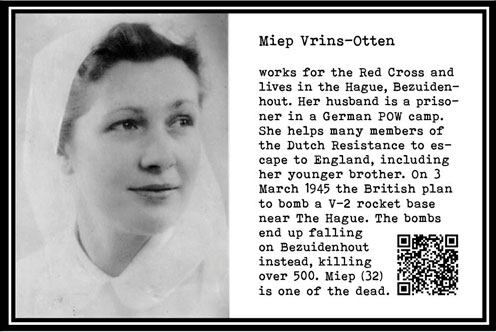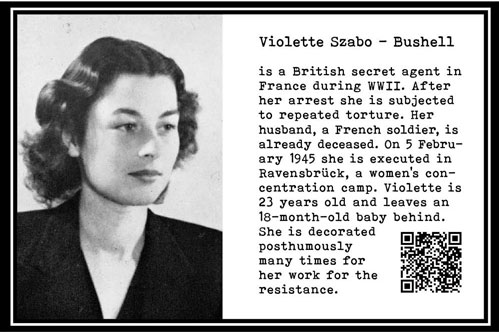World War II (WWII), which begins on 1 September 1939 with the German invasion of Poland, pits the Allies (including Britain, the Soviet Union, and, from 1941, the United States) against the Axis powers (notably Germany, Italy and, from 1941, Japan).
In May 1940, the Netherlands, Belgium, and large parts of France are occupied by German troops. The battle took place on fronts in Western Europe, Russia, Africa, Southeast Asia, and the Pacific. After the British-American invasions, on 9 July 1943 in Sicily and on 6 June 1944 in Normandy, the odds turn and Germany is forced onto the defensive.
On 7 May 1945, Germany’s surrender ended the war in Europe. After Hiroshima and Nagasaki are destroyed by two atomic bombs in early August, Japan capitulates on 15 August.
Casualties: between 70 and 72 million dead, of whom it is estimated some 25 million were military, 40 million civilians, and 6 million Jewish Holocaust victims. Of the belligerent countries, the Soviet Union is hardest hit with nearly 11 million military and nearly 12 million civilian casualties
 The monument to the Partisan women of Venice
The monument to the Partisan women of Venice
Location:Italy, Venice, Castello Sestieri, the Venice Giardini
Design: Augusto Murer
Unveiling: 1969
Photo: Creative Commons
At this location, seven political prisoners, including some partisans, are murdered by the Nazis on 3 August 1944. The partisans, socialists communists, were fighting both the Germans and fascists at home. The latter is exceptionally cruel by torturing opponents to death and also killing their wives and children. After the end of the occupation, the partisans take revenge. During WWII, around 460,000 soldiers and civilians died and were killed throughout Italy.

Monument to the prisoner of concentration camp Mittelbau-Dora
Location: Germany, Thüringen, Nordhausen, Kohnsteinweg 20
Design: Jürgen von Woyski
Unveiling: 2003
Photo: A Polish Journey
An underground factory for the production of V-1 and V-2 rockets (V= retaliatory weapon) located in the outer camp of Buchenwald concentration camp from autumn 1943. Concentration camp prisoners and forced laborers, men and women, are locked up here and have to work day and night. Many of them die after only a few weeks because of the terrible working and living conditions. The number of victims is estimated at more than 26,000.

Merchant Seafarers’ War Memorial
Inscription: IN MEMORY OF THE MERCHANT SEAFARERS FROM THE PORTS OF BARRY, PENARTH, CARDIFF WHO DIED IN TIMES OF WAR”
Location: United Kingdom, Wales, Cardiff Bay, Pierhead Street
Design: Brian Fell
Unveiling: 1994
Photo: The Cardiffian
The British merchant navy becomes intimately involved in the war. It is vital to supply the homeland with raw materials, weapons, ammunition, fuel, food, and everything needed for defense. The ships are in constant danger not only from shelling by German submarines but also from attacks from the air. The British fleet numbers 200,000 crew members worldwide, and 30,248 of them die.
 ‘The family’
‘The family’
Location: Servia, South-Backa, Novi Sad, Beogradsky Kej
Design: Jovan Soldatović
Unveiling: 1992
Photo: Wikimedia Commons
This four-meter-high statue commemorates the victims of the ‘Novi-Sad roundup’. In January 1942, the Hungarian occupation forces murdered more than 1,300 Jews, Gypsies, and other Serbs in a systematically prepared operation. Many victims are killed on the city beach where their bodies are thrown into pools of the Danube.

‘The unconquered Kaminsky and his son’
Location: Belarus, Minsk/ Lahoisk District, Khatyn memorial complex
Design: Sergei Selichanow
Unveiling: 1969
Photo: Wikimedia Commons
On 22 March 1943, almost all 156 inhabitants of Chatyn are burned alive in a barn by the Nazis. Chatyn is a symbol of the genocide of the Belarusian civilian population: 5,295 villages are destroyed, dozens of them several times, sometimes up to five times. In 618 villages, the population is burned alive. 136 villages are never rebuilt. More than 2,230,000 Belarusians (a quarter of the population) do not survive the Nazi occupation.

‘The Grieving Widow’ also called ‘The Lady of Putten’
Location: the Netherlands, Gelderland, Putten,
Design: Mari Andriessen
Unveiling: 1949
Photo: Tourist Information Putten
The Putten resistance movement made an attack on Wehrmacht officers in 1944, which failed. The next day, on 1 October, the occupying forces carry out a raid on the village in retaliation. A total of 110 houses were destroyed. On 3 October, the women, boys, and old men slowly return to Putten. Of the 659 deported men, 58 are released from Camp Amersfoort after a medical examination. Fourteen manage to escape during the beginning of the transport from Amersfoort to Neuengamme, Ladelund, and other concentration camps. After the war, 49 men return to the Netherlands, where another five die as a result of the hardships. A total of 552 people die.

‘Crying Woman’
Location: Czech Republic, Central Bohemia, Lidice, Tokajická 152, Lidice Memorial
Design: Bedřich Stefan
Unveiling: 1957
Photo: Lidice Memorial in pictures
After the assassination of Governor Reinhard Heydrich in 1942, Hitler orders Bohemia to wade through blood. The most famous revenge attack is against the mining village of Lidice, where all the men are killed immediately. The women and children almost all perish in concentration camps. The village itself is razed to the ground by bulldozers. Two weeks later, the same fate befalls Ležáky. The number of victims of the revenge attacks is estimated at 1,300.

Monument without name
Location: Germany, North Rhine-Westphalia, Schwerte-Oost, Emil Rohmann- Straße
Design: Horst Wegener
Unveiling: 2005
Photo: Neue Rhein/Neue Ruhr Zeitung
This workshop for repairing steam locomotives was part of the German war industry from 1944. Hundreds of prisoners, mostly Polish and Russian, from the Buchenwald concentration camp are employed here. Working conditions are harsh and there is a lack of food. Every month, 20% of the men drop out due to death or illness. As the Allied front approaches, the camp is cleared on 29 January 1945.

Monument for the victims of the massacre in Amiras
Location: Greece, Crete, Viannos, Amiras
Design: Yiannis Parmakelis
Unveiling: 2007
Photo: Wikimedia Commons
In 1943, in response to a major attack by partisans, the German occupation forces destroy about 20 villages in the southern part of Crete. In the process, the more than 500 inhabitants are killed. Each village has its memorial. The large joint memorial stands in Amiras.

‘Solidarity’ | To the victims of the damning V-weapons Antwerp 1944 – 1945
Location: Belgium Antwerp, Jules Moretuslei, City Cemetary Schoonselhof
Design: Ernest Denis
Unveiling: 1947
Photo: Helena van Essen
Antwerp is liberated by the Allies on 4 September 1944. But then, between 13 October 1944 and 27 March 1945, 3,709 V-1 and V-2 bombs fell on Antwerp, killing over 5,000 people and destroying 7,000 homes. The V-1s can be seen and heard, but no alarm can be given for the silent V-2s, such as those falling on Cinema Rex (567 dead). Antwerp is thus ‘The City of Sudden Death’.

Relief, part of the Bittermark monument
Location: Germany, North Rhine-Westphalia, Dortmund, Theodor-Freywald-Weg
Design: Karel Niestrath
Unveiling: 1960
Photo: Wikimedia Commons
The Gestapo removes 300 people from prisons in Dortmund, Bochum, and Herne. They are German resistance fighters and forced laborers from France, Belgium, the Netherlands, Yugoslavia, Poland, and the Soviet Union. They are taken to the Bittermark forest and murdered there between 7 March and 12 April 1945. On 13 April 1945, the Americans occupy the area.

‘The Monument to the Women of the Second World War’
Location: United Kingdom, London, White Hall
Design: John W. Mills
Unveiling: 2005
Photo: Stevebidmead
During World War II, British women are encouraged to participate in social life and contribute to the war effort while also managing their domestic responsibilities. Starting in 1941, women are conscripted for various roles including mechanics, engineers, ammunition workers, air raid wardens, and drivers of buses and fire engines. Additionally, over 640,000 women serve in the armed forces, undertaking tasks such as flying unarmed aircraft, driving ambulances, and working as nurses. Furthermore, 60 women operate behind enemy lines in the European Resistance as part of the Special Operations Executive.



